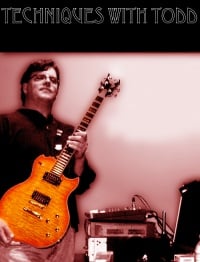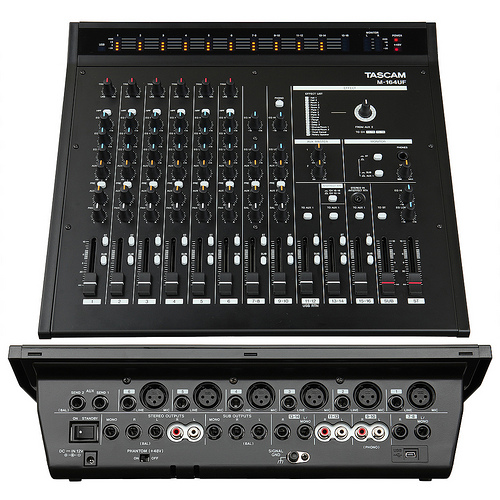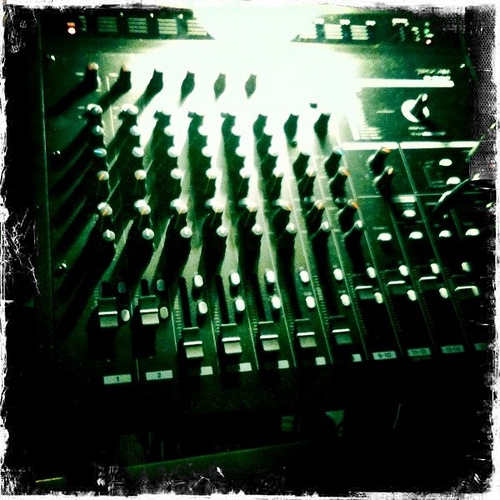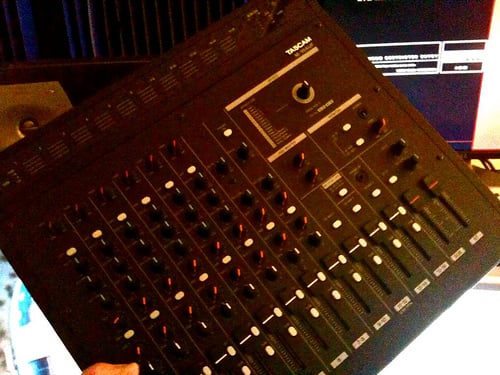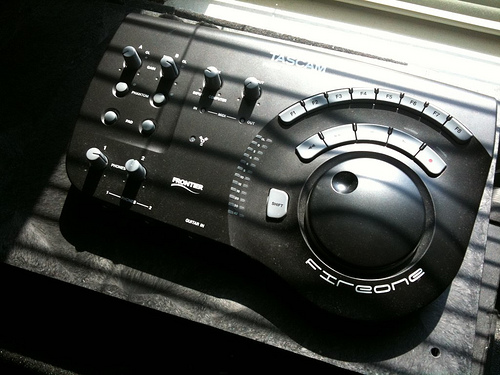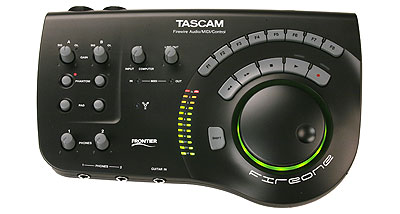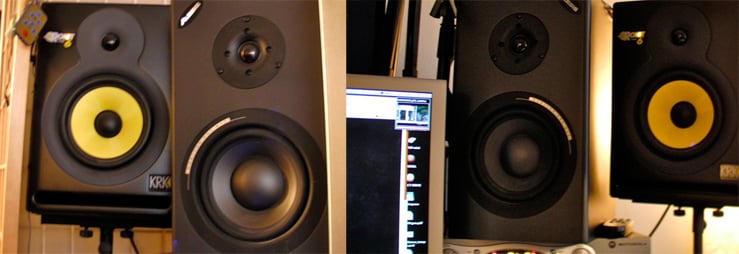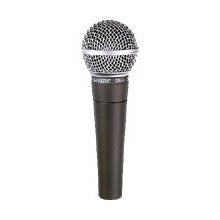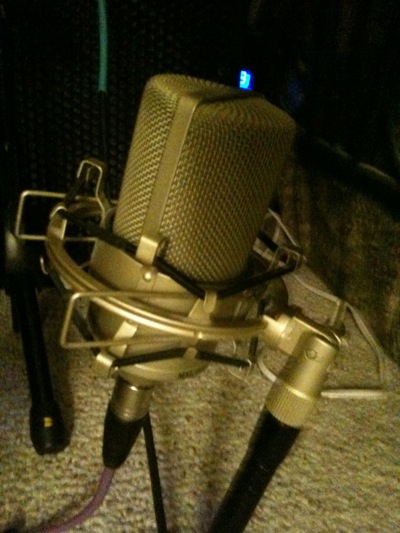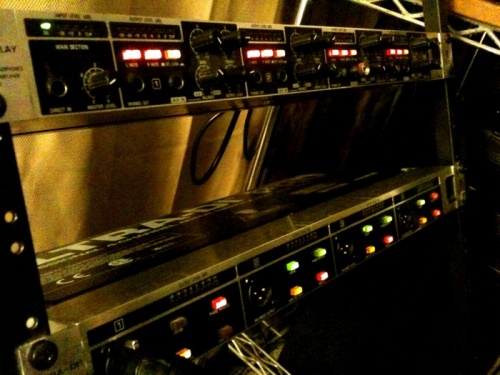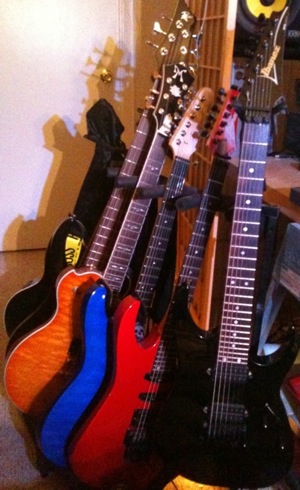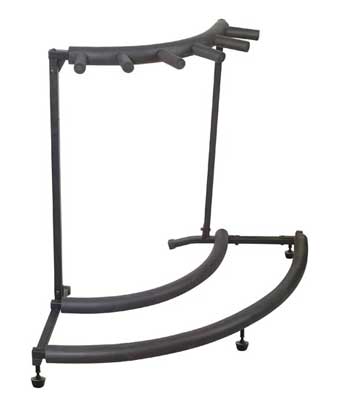Equipping The Home Studio
| Line 147: | Line 147: | ||
== Mouse vs Trackball == | == Mouse vs Trackball == | ||
| + | |||
| + | You may have noticed, maybe not, that a LOT of Studios have a TRACKBALL instead of a MOUSE for controlling the computer in the studio. Certainly not all. But a LOT of professional studios have a trackball sitting on the console or below the computer monitor. It's usually the same Model as well. It's either one of two Kensington units. Either it's the "EXPERT MOUSE" (the black ball) or the "SLIM BLADE" (Red Ball, which is what I use as it allows you to scroll web pages by simply rotating the ball which is very handy, and the click response requires very little effort thus reducing hand fatigue). | ||
| + | |||
| + | |||
| + | Sometimes it's the wireless variant. These units run about $100 typically. Some consoles have a track ball built in such as in this pic. Which also has a track ball on the computer control stand (expert mouse) | ||
| + | |||
| + | |||
| + | The reason is simple. Performance. Once a user gets used to using the trackball, it's just flat out faster and in a studio time is money. Also, they reduce strain on the wrist which can lead to carpal tunnel syndrome/repetitive stress injury. That's why I first switch to one. I used the computer so much I injured myself. I was practicing too much as well. The trackball helped. As a bonus, I got way faster than I ever was with a mouse. Here is a video about the trackball with some interesting factoids. Anyone else out there a trackball user? | ||
| + | |||
| + | |||
| + | As long as we are on ergo stuff for the studio, here is a new keyboard that is being done through crowd funding for gaming that would be great for a studio imho. I think I'm gonna get one!! IT's a "split" keyboard which reduces hand strain/fatigue. The mouse is more important imho for studio use as we spend more time mousing than we spend typing when working on music. This has some great features on it. | ||
| + | |||
| + | |||
| + | Personally, I've been using a wireless IOGEAR wireless multimedia keyboar for years in my studio. It's got laptop style keys which I find helps with speed/reduces fatigue as the push pressure is very small, and it's got a built in trackball!!! So that If I'm leaning back in my chair and can't quite be bothered to reach up for the big trackball, it's fine. smile.gif These run [https://amzn.to/2VP11giabout $45 on amazon] | ||
Revision as of 13:54, 26 February 2019
Equipping The Home Studio
An Article by Todd Simpson
Introduction
This article is about my experience with different recording gear. I've owned a few different audio interfaces and thought I'd share my experience and invite others to do the same.
CHOOSING A RECORDING INTERFACE: Tascam M-164UF
I just added a Tascam M-164UF to my home studio and I love it so far. It's a 16 channel mixer/recording interface and connects via usb 2.0. There is no perceptible lag or delay when recording which is great. This device can be had for about $300 US and is an amazing value. So far it's the best interface I"ve ever had. It's PC and Mac comptitble, works with any DAW and the Mic preamps sound great especially for the price. It's not a Pro level unit Ala ProTools HD, but the gap betwen prosumer and pro continues to narrow. Here are a couple of pix.
It will let you record 16 tracks (6 with their own mic pre-amp) at once in to whatever software you are using. So if you want to record a drum kit, or just put several mics on your guitar rig, it's no problem. My previous units had one or two XLR inputs and recorded one or two channels at a time, this one has 6 xlr inputs and does 16 tracks at once. More review to follow as I continue to record with it.
Tascam FIREONE
TASCAM FIREONE Street Price (Around $150 Online)
I used a Tascam FireOne for about a year and was very happy with it. This is a FIREWIRE audio interface with 2 XLR Jacks that are also able to take quarter inch guitar plugs (standard guitar cable) There is also a quarter inch input on the front for putting guitar cable in to the interface without needing to get behind it.
This interface can also be used as a "Control Surface" meaning that the buttons and large jog wheel can be used to control whatever software you are using. Setting it up to actually control the software was sometimes hit or miss as it didn't ship with templates and most software doesn't instantly recognize as a controller. Still, it can be "mapped" manually and can be very handy for transport control (record, play, scrub, etc.)
The audio quality of the unit was quite good and I never had any technical issues with it. It was simply rock solid and sounded great. It works on Mac or PC, and supports MIDI. You can find these now quite cheap as it's an older model but stock is still being sold. They no longer make this one at Tascam but continue to offer drivers for it. Here is a link to the tascam site with more info.
TASCAM WEB SITE PRODUCT FIREONE
Monitors/Speakers For Mixing/Recording
There is an old saying "Whatever your mixing speakers are good at, your mixes will be bad at" So if your mixing speakers are really good at mid range and high range, then your mixes tend to sound flat when played on systems with a flat e.q. curve. If your speakers have great bass, then your mixes may lack bass when played on a system with a flat e.q. response.
Ideally, you want your speakers to be "neutral" without too much boom, or tweet. That way, you know what you are getting in your mix. If your speakers accentuate any part of the sound spectrum, it will be obvious when you play the mix on other systems.
I use two pair of monitors, KRK ROKIT 6 and Alesis MK2.
Both are paired to a subwoofer. I go back and forth between them when mixing which is a common approach. Mixing on just one pair of speakers can yield uneven results when played back outside of your mix room.
Buying the first microphones
First of all here's a nice article for you to read about Microphone types
As you equip your home studio, you will need some Mics. A good place to start is the traditional SHURE SM-58. The 58 is a "Dynamic Microphone" You can use it for vocals, you can use it on a guitar cab (the windscreen screws off and on) you can use it on drums. Really on just about anything and it will sound good. These Mics are legendary for the durability and predictable sound quality. They run about $100 and make a great first mic. Here is a pic:
Adding a condenser microphone to your home studio
I'd also suggest you get a "Condenser Microphone". These are typically a bit brighter than dynamic mics and a bit more sensitive. They can't take as much sound pressure (e.g. volume) as the dynamic mic but generally offer superior dynamic range and frequency response. In short, they sound a bit better. The good news is you can get one cheaper than a SM-58 and it's flexible enough to record just about anything. Just don't put it close to a drum kit or a really loud guitar amp or you can wreck it. They are a bit more fragile than dynamic mics. I have tried wads of condenser mics and for the money I love this one.
MXL-990 Condenser Microphone ($50 on sale)
Here is a sample of my Ibanez 7 string recorded with this mic: condensermic.mp3 ( 209.02K )
Working with software guitar emulators
Working with software such as AMPLITUDE or GUITAR RIG is a great way to get killer tones using just your computer. However, in order to get the right signal in to your computer you may need a specific piece of gear. It's called a DIRECT BOX. A recording engineer buddy of mine turned me on to adding at DI box in to the signal chain when recording clean and using software emulation. I couldn't believe the difference.
You see, your recording interface may or may not be dealing well with your guitars line level signal. If you notice that you are not getting enough gain/distortion, and there is too much noise in the signal, a direct box might be your answer.
The direct box takes your guitars Line Level Signal and converts it to Mic Level, this then gets sent in to your recording interface. It made all the difference for me with my currrent recording interface. Here is a test I made after getting my direct box and using Guitar Rig 4.
GuitarRigMonsterGain_copy.mp3 ( 1.38MB )
Here is a pic of the direct box I'm using (It's the unit on bottom, the top one is a headphone distribution amp). It's a Behringer rack mount unit. They run about $50 used at a music store or ebay. The rack mount is handy in that you can plug it in to the wall for power. Smaller units require batteries which can be a pain.
Too many guitars, too few stands?
If you have several guitars in your collection, it can be a pain to keep them on on separate stands and still have them within easy reach for recording. When settting up my home studio, I wanted to be able to have all of my guitars within arms reach. The solution came in the form of the ROCSTAND multi-guitar stand. This can be had for about $75 and holds 7 guitars! Here is a link to a vendor who carries it.
Here is a pic of the stand in my home studio:
And here is a pic of the item with no guitars on it:
In short, this thing is way handy if you have a bunch of guitars and not a bunch of space in your home studio.
Mouse vs Trackball
You may have noticed, maybe not, that a LOT of Studios have a TRACKBALL instead of a MOUSE for controlling the computer in the studio. Certainly not all. But a LOT of professional studios have a trackball sitting on the console or below the computer monitor. It's usually the same Model as well. It's either one of two Kensington units. Either it's the "EXPERT MOUSE" (the black ball) or the "SLIM BLADE" (Red Ball, which is what I use as it allows you to scroll web pages by simply rotating the ball which is very handy, and the click response requires very little effort thus reducing hand fatigue).
Sometimes it's the wireless variant. These units run about $100 typically. Some consoles have a track ball built in such as in this pic. Which also has a track ball on the computer control stand (expert mouse)
The reason is simple. Performance. Once a user gets used to using the trackball, it's just flat out faster and in a studio time is money. Also, they reduce strain on the wrist which can lead to carpal tunnel syndrome/repetitive stress injury. That's why I first switch to one. I used the computer so much I injured myself. I was practicing too much as well. The trackball helped. As a bonus, I got way faster than I ever was with a mouse. Here is a video about the trackball with some interesting factoids. Anyone else out there a trackball user?
As long as we are on ergo stuff for the studio, here is a new keyboard that is being done through crowd funding for gaming that would be great for a studio imho. I think I'm gonna get one!! IT's a "split" keyboard which reduces hand strain/fatigue. The mouse is more important imho for studio use as we spend more time mousing than we spend typing when working on music. This has some great features on it.
Personally, I've been using a wireless IOGEAR wireless multimedia keyboar for years in my studio. It's got laptop style keys which I find helps with speed/reduces fatigue as the push pressure is very small, and it's got a built in trackball!!! So that If I'm leaning back in my chair and can't quite be bothered to reach up for the big trackball, it's fine. smile.gif These run $45 on amazon



